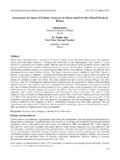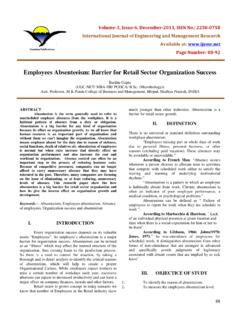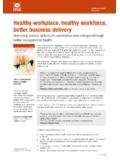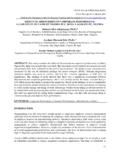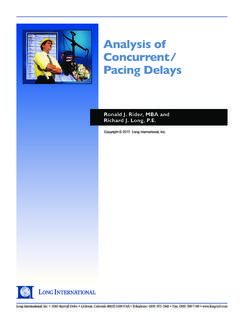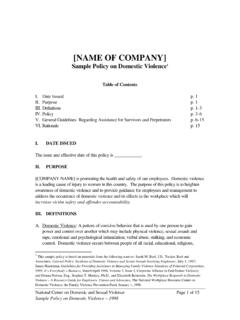Transcription of Sleep, Performance & the Workplace - Sleep Center of ...
1 Sleep , Performance Sleep , Performance & the WorkplaceOverview Why Sleep is Important The Consequences of Fatigue in the Workplace The Consequences of Fatigue in the Workplace Shift Work Perils and Countermeasures Common Sleep Disorders and Problems NSF H lth SlTiEdtil M t i l NSF Healthy Sleep Tips, Educational Materials and National Campaigns & ProgramsWhy Care About Sleep ? Sleep is Vitally For all human functioning Cognitive & physical Performance Restorative properties of REM Sleep Learning & memory consolidation Mood enhancement Mood enhancement Protects the immune system New evidence shows a relationship to weight pggain and agingInstitute of Medicine ReportInstitute of Medicine Report An Unmet Public Health Problem The cumulative effects of Sleep loss and Sleep disorders represent an under-recognized public health problem and have been associated with a pwide range of health consequences including an increased risk
2 Of hypertension, diabetes, obesity, depression, heart attack, and 20 percent of all serious car crash injuries in thepercent of all serious car crash injuries in the general population are associated with driver of billions of dollars a year are spent on direct medical costs related to ypsleep disorders such as doctor visits, hospital services, prescriptions, and over-the-counter medications. Higher Medical Costs Undiagnosed or untreated Sleep disorders sufferers utilize the healthcare system moresufferers utilize the healthcare system more frequently Untreated Sleep apnea may cause $ billion in ppy$additional medical costs People with insomnia use more health care presources than those without insomnia Sleep is Regulated by two pgyBody Systems Sleep /Wake Restorative ProcessProcessBalances Sleep & Wakefulness Circadian Biological ClockRegulates Timing of Sleep & WakefulnessWakefulnessSleep Needs Vary Over th Lif Clthe Life
3 CycleNewborns/0-2 months10 5-18 hoursNewborns/Infants0 -2 months2 - 12 hours14-15 hoursT ddl/12 - 18 months13-15 hoursToddlers/Children18 months - 3 - 5 - 12 hours11-13 hours10-11 hoursAdolescentsOn hoursAdults/Older On Average7-9 hoursPersonsOn Average79 hoursSleep Patterns & Characteristics ChOth Lif ClChange Over the Life CycleNewborns/InfantsMore active in Sleep ; 50% REM; several periods of Sleep ; need napsToddlersSleep begins to resemble adult patternsToddlersSleep begins to resemble adult patternsChildrenExperience more deep sleepAdolescentsShift to later Sleep -wake cycle; experience daytime AdolescentssleepinessAdultsNeed regular Sleep schedule to obtain sufficient, quality Sleep Older AdultsMore likely to have medical problems; Sleep disrupters & disorders.
4 Sleep less efficientlyYour Sleep NeedThe average amount of Sleep youmust obtain on a daily basis to maintain alertness & avoid building up a Sleep DebtSleep Debt Each hour of lost Sleep is added to your Sleep debt. Your Sleep debt can only be reduced by getting extra Sleep . However, you may not be able to reverse the yylong-term effects of Sleep deprivation. The larger your Sleep debt, the more likely you will experience Sleep The average American sleeps less than 7 hours 37% of adults say they are so tired during the day it interferes with daily activities 75% f d ltit ltt 75% of adults experience at least one symptom of a Sleep disorder a few nights a week or more 55% of adults nap at least once during the %pgweekSource.
5 NSF Sleep in AmericaPollsWhy We Aren t Volitional Sleep deprivation (work, lifestyle) Poor Sleep habits Circadian factors (shift work) Environmental disruptions Untreated Sleep problems/disorderspp We don t take Sleep seriously!!!Medical Illness Linked to Sleep LdSlDidLoss and Sleep Disorders Sleep Loss Sleep Loss Increased age-specific mortality Depressive symptoms, anxiety and Depressive symptoms, anxiety and alcohol use Obstructive Sleep Apneapp Hypertension Stroke & cardiovascular disease Impaired glucose tolerance ObesityFatigue in the WorkplaceThe Effects of SleepinessThe Effects of Sleepiness & Fatigue Impaired reaction time, judgment & vision Problems with information processing & short-pgterm memory Decreased Performance .
6 Vigilance & motivation Increased moodiness & aggressive behaviors Increased microsleeps brief (2/3 seconds) Sleep episodess eep ep sodesEffects of Sleepiness on WorkWhen sleepy, people report having difficulty with: Concentration-68% Handling stress-65% Relating to others-38% Solving problems-57% Listening-57% Decision making-56%Source: NSF 2000 Sleep In AmericaPollWork Problems Due toWork Problems Due to Sleepiness Late to work 14% Stay home from work4% Stay home from work 4% Fall asleep at work 7% Mk19% Make errors 19% Get injured 2%Source: NSF 2000 Sleep In AmericaPollSleep-Related Fatigue CostsSleepRelated Fatigue Costs Sleep -related fatigue costs for US Sleeprelated fatigue costs for US businesses have been estimated at $150 billion a year for:$150 billion a year for: Absenteeism Wklid t Workplace accidents Lost ProductivitySleep Loss and Work Related Injuries Highly fatigued workers are 70% more likely to be involved in accidents.
7 W kith hi ii hhi h Workers with chronic insomnia have higher rates of accidents. Those who report disturbed Sleep are Those who report disturbed Sleep are nearly twice as likely to die in a work related accidentrelated t h D t FtiCatastrophes Due to Fatigue Union Carbide chemical plant in Bhopal Chernobyl Chernobyl Three Mile Island Exxon-ValdezThe Consequences of qSleep Deprivation on the Hi hHighwayFtiAl hlFatigue vs. Alcohol 17 hours sustained wakefulness produces 17 hours sustained wakefulness produces Performance impairment = BAC 24 hours= BAC(Dawson & Reid, 1997; Williamson 24 hours BAC (Dawson & Reid, 1997; Williamson & Feyer, 2000).)
8 People with mild to moderate untreated Sleep apnea performed worse than those with aapnea performed worse than those with a BAC (Powell, 1999) On 4 hours Sleep , 1 beer can have the impact On 4 hours Sleep , 1 beer can have the impact of a six-pack (Roehrs et al., 1994)Alertness Strategies Recognize signs of fatigue Be aware of circadian factors (post-lunch dip) A id b ildild bt Avoid building a Sleep debt Be aware of sedating medications use alternatives if availableavailable Take Power Naps (20 minutes in late morning/early afternoon)When 9:00 to 5:00 When 9:00 to 5.
9 00 Isn t an OptionpSleep Strategies for Shift WorkersSleep Strategies for Shift WorkersThe Perils of Shift Work Depression Digestive & Depression Stress & anxiety Divorce Digestive & gastrointestinal problems Cdil Divorce Increased smoking More errors & Cardiovascular disease Higher cholesteroloee os&accidentsg Possible Carcinogen**World Health Organization (WHO) Report Economic Impact of Sleep Problems Due to Late Shifts Reduced Manufacturing productivity 50B Increased motor vehicle accidents Increased industrial accidents = 4B Increased accidents, injuries, and deaths at work Iithdi ldhi t i ill2B Increase in other medical and psychiatric illnesses 2B Personnel turnover and retraining 1 BTotal economic impact in billions Closer Look at NursesA Closer Look at Nurses 74% of nurses work 12 hour shifts 74% of nurses work 12 hour shifts On average.
10 Over 15% of nurses fall asleep on the job in a thirty day Nurses working 12 hour shifts report more errors per shift than nurses working 8 pghour shifts Nurses working 12hr shifts have higher absenteeism rates than nurses working 8 hour shiftsShift Work:Promoting Alertness at Work Take short breaks Schedule demanding Use the buddy systemgtasks when you are most alert Share ideas with others Exercise on breaks Use caffeine as a tool not as a crutch Share ideas with others in the same position Eat healthynot as a crutchShift Work:Promoting Sleep at HomeLIGHT Darken the bedroom &SOUND Wear ear plugs or white Darken the bedroom & bathroom Install light blocking & db bii Wear ear plugs or white noise machine Install carpeting & drapes to absorb soundsound absorbing curtains or shades Wear eye shadesabsorb sound Unplug the telephone & publicize your work schedule to family & friendsy Wear dark sunglasses on the drive homeschedule to family & friendsRecognizing Sleep Problems & DisordersProblems & DisordersSleep Problems/Disorders CanSleep Problems/Disorders Can be Serious Symptoms

